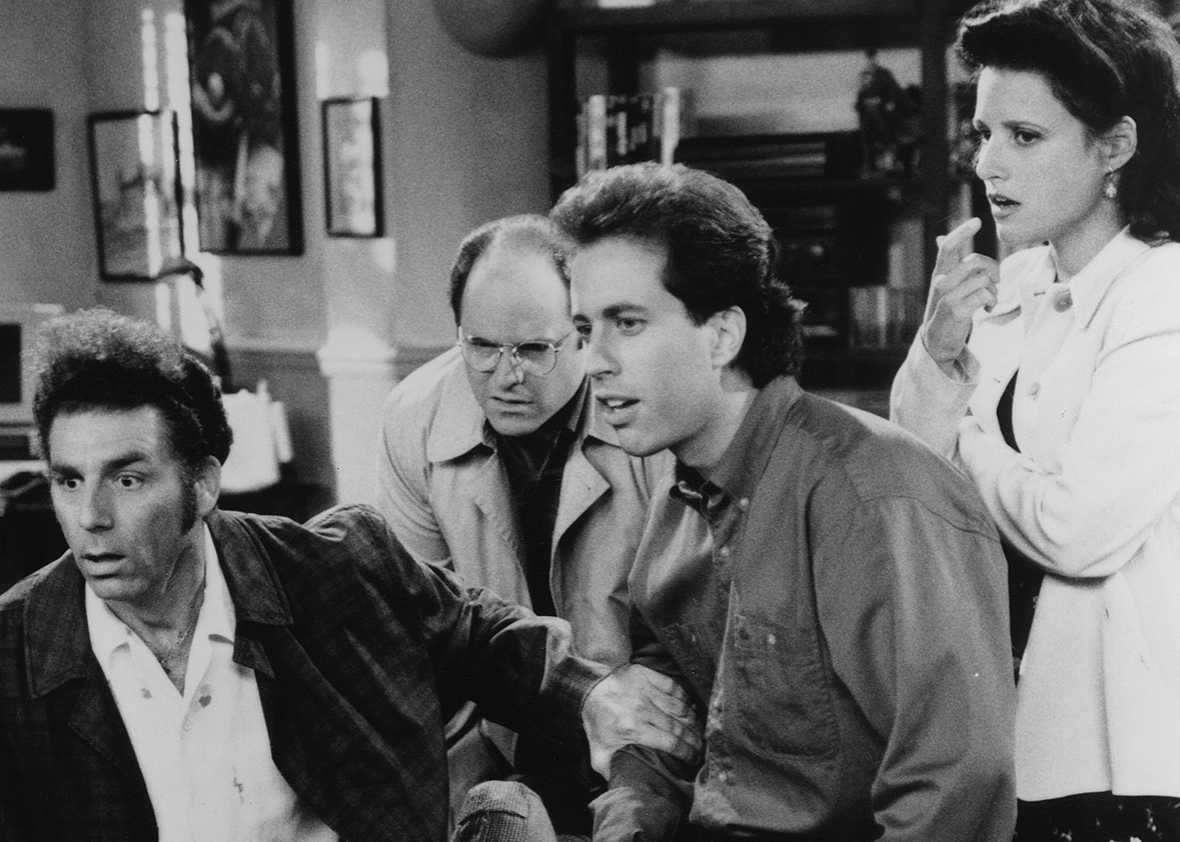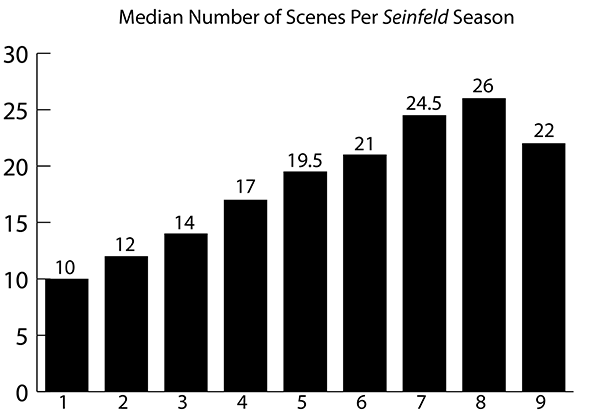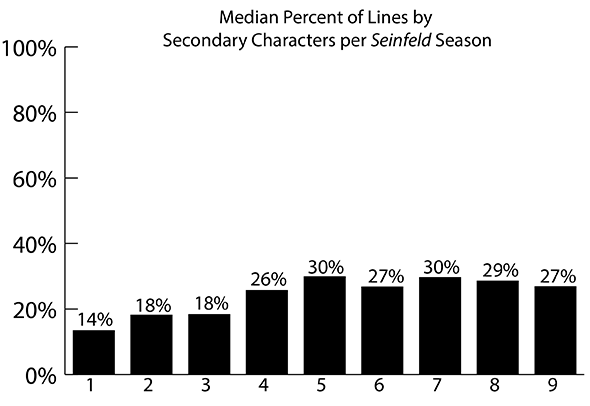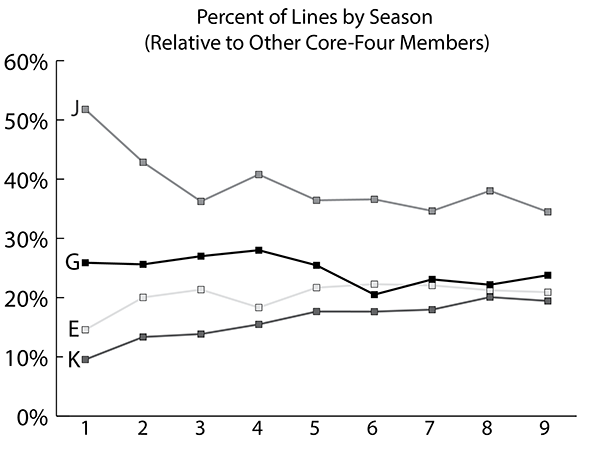The Evolution of Seinfeld
For a show about nothing, the sitcom changed a lot over its nine-year run.

Photo by NBC/NBCU Photo Bank via Getty Images
Seinfeld was a self-described show about nothing in which nothing much ever changed. Between its first and ninth season, the show’s basic setup went unaltered. None of the four leads ever departed, and no new major characters were added. No relationships stuck. Jerry’s apartment and Monk’s Café remained the sitcom’s main settings.
As a result, it can sometimes be hard to place a Seinfeld episode by season when you happen upon a rerun playing on cable. Even a series like Friends, which was similarly static in terms of its characters and sets, is more easily dated by looking for clues in the relationships among the six main characters: If Chandler and Monica are together, you know you’re in Season 4 or later.
But Seinfeld did change over time—it’s just that the changes are subtle. Now that the series is available on Hulu, where viewers can easily watch it in sequence, I decided to look at a few ways the show grew over its 180 episodes. To do so, I downloaded transcripts of every episode from the fan site Seinology.com in order to offer some theories on the evolution of nothingness.
Pace
In a recent episode of Jerry Seinfeld’s Web series Comedians in Cars Getting Coffee, Julia Louis-Dreyfus said that when she received her first Seinfeld script, she thought, “Nothing had ever been written like that before, like it was just a conversation as opposed to a setup, punch line, setup, punch line. And I just remember thinking, ‘This is so nice and relaxed.’ ”
The first season of the series was relaxed—but that didn’t last for long. There is a major change in episode pace between the sedate first season and the frantic final ones. Even casual fans may have noticed this.

Chart by Ben Blatt
In the first season, the typical episode had just 10 scenes. Of these, a couple were normally dedicated to Jerry performing comedy bits on stage. By the final seasons, the typical episode had 20 to 25 scenes, and Jerry’s monologues had been eliminated. The average scene length dropped from more than two minutes to less than 60 seconds. (I excluded episodes 100, 101, 177, 178, 179, and 180 from my analysis as they contain clips of previous shows. The two-part finale has 65 scenes, nine of which are flashbacks.)
There are a few episodes that are famous outliers in terms of scene count. “The Chinese Restaurant,” from Season 2, never leaves the restaurant except for an opening and closing monologue by Jerry. But if you play with the interactive at the bottom of this article, you’ll see that the exceptions are not the underlying cause of the trend toward a more frenetic pace. The episode with the least number of scenes in Season 8, the fastest-paced season, is “The Van Buren Boys,” with 19. That’s more scenes than any episode in the first two seasons.
Secondary Characters
Along with the quickening pace came intersecting A and B storylines, in which each of the four main characters ventured off from the rest of the group. In the first episode of Seinfeld, Jerry is in every scene. There are no diversions into the lives of Kessler (as Kramer was called in the pilot), Elaine (who was not even in the first episode), or George. The vast majority of the show is, as Dreyfus said, “just a conversation.”
By the final seasons, however, secondary characters were playing a much larger role in the series. In the first three seasons, lines by secondary characters accounted for less than 18 percent of a given script. By the last five seasons, they accounted for between 25 and 35 percent.

Chart by Ben Blatt
Here, too, there are a few outlier episodes. For instance, there are two episodes in the history of the show in which the four main characters accounted for less than half of all lines. In “The Pen,” in which Jerry refuses to accept a space pen as gift from retiree Jack Klompus, Jerry and Elaine speak less than 40 percent of all lines while Kramer and George do not even appear. In “The Raincoats, Part 2,” the core four combine for just under 50 percent of all lines as Jerry argues with his father and Jack Klompus over the shipment of beltless raincoats.
The Rise of Kramer
When Kramer enters Jerry’s apartment, he does so in one sudden motion. Kramer’s emergence as a full-fledged member of the core four was a more gradual affair.
The interactive below shows the percentage of lines spoken by the core four compared with each other. (In other words, if George accounts for 20 percent of all lines, it means that one-fifth of all lines spoken by either Jerry, George, Elaine, or Kramer are from George.) Jerry hogs a high fraction the script for the first two seasons before mellowing out. George edges down a hair over the run of the series, while Elaine edges up, but the changes are slight.
In the second episode of the series, Kramer has six lines—mostly about Scrabble. It’s fewer than half the number both Morty and Helen Seinfeld have in the same episode. (Indeed, that episode dedicates more time to discussing the import-export business of Art Vandelay than it does to Kramer.) When Seinfeld began its run, it was almost as if Kramer was trapped in Jerry’s building. It’s not until the fifth episode of the second season that we see him in a scene outside Jerry’s apartment and without Jerry.
Gradually, however, Kramer goes from being a fringe character to one on equal footing with the rest of the cast, doubling his share of lines from the first to the last season. Still, he never quite catches up to the rest of the main characters. In the last season, George still had 20 percent more lines than Kramer. Of course, it’s also the case that, moreso than any other character, Kramer’s contributions came in the form of physical, not verbal, comedy.

Chart by Ben Blatt
And despite Kramer’s slow start, he accumulated 10 times as many lines over the course of the series as any secondary character. George Costanza’s boss, George Steinbrenner, has 2 percent of the amount of lines Kramer does. Steinbrenner places ninth in terms of most lines of a secondary character. That’s just ahead of Kramer’s friend Mickey (10th) and Ovaltine fan Kenny Bania (11th) but behind Puddy (ranked eighth), J. Peterman, Estelle Costanza, Susan (George’s late fiancee), Frank Costanza, and Helen and Morty Seinfeld (ranked third and second, respectively).
Jerry’s parents reeled off an impressive number of lines for characters who only appear intermittently throughout the series’ run. But there is one secondary character who spoke more often. One man who talked more than Jerry’s parents. More than Uncle Leo. More than everyone outside the core four. Who was that man? Newman.